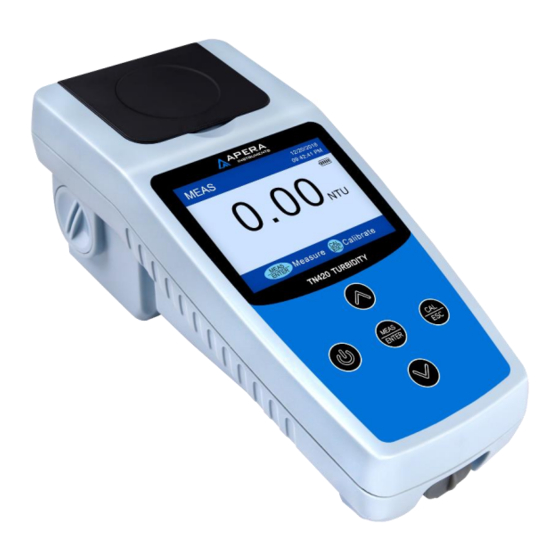Summary of Contents for Apera Instruments TN420
- Page 1 TN420 Portable Turbidity Meter Instruction Manual APERA INSTRUMENTS (Europe) GmbH www.aperainst.de...
-
Page 2: Table Of Contents
TABLE OF CONTENTS INTRODUCTION ........................- 1 - TECHNICAL SPECIFICATIONS ....................- 2 - INSTRUMENTATION ILLUSTRATION ..................- 3 - Overview ..........................- 3 - Configuration ........................- 4 - Display Mode ........................- 4 - Keypad ..........................- 5 - Power Supply ........................ -
Page 3: Introduction
1. INTRODUCTION Thank you for purchasing Apera Instruments TN420 Turbidity Meter (hereafter referred to as the instrument). The instrument uses tungsten filament lamp (400 – 600nm) as the light source and 90° scattering method, which is compliant with U.S EPA 180.1 method for the determination of of turbidity in drinking, ground, surface, and saline waters, domestic and industrial wastes. -
Page 4: Technical Specifications
2. TECHNICAL SPECIFICATIONS Measurement Method 90° scattering measurement Tungsten (400 – 600nm) filament lamp, compliant with US EPA 180.1 Light Source Method 0 to 1000 NTU (FNU), automatic range switch 0.01 to 19.99 NTU (FNU) Measuring Range 20.0 to 99.9 NTU (FNU) 100 to 1000 NTU (FNU) Accuracy ≤... -
Page 5: Instrumentation Illustration
3. INSTRUMENTATION ILLUSTRATION Overview ① ② ③ ⑪ ④ ⑥ ⑤ ⑧ ⑨ ⑩ ⑦ Diagram-1 ① ⑦ Flip cover of the sample vial holder Dust-proof plug (Take off the plug when (Close the cover when measuring) measuring) ② ⑧ Housing Sample vial holder ③... -
Page 6: Configuration
3.2 Configuration Calibration Solutions: ① 0.0, 20.0, 100, 400, 800 NTU ⑨ ② Carrying case ③ TN420 Turbidimeter ① ④ Microfiber cloth ② ⑤ Power adaptor (5V 1A) ③ ⑧ ⑥ Silicone oil (10 ml) ④ ⑦ Sample vials×6 ⑦... -
Page 7: Keypad
① Calibration mode Calibration ② Standard values Menu ③ Operation guide ④ Finished calibration indicator 3.4 Keypad Diagram 3 Functions ⚫ Power on/off ⚫ In measurement mode: press to enter calibration mode ⚫ In calibration mode: press to exit calibration mode ⚫... -
Page 8: Power Supply
3.5 Power Supply The instrument adopts 3.7V rechargeable lithium battery. Fully charge the battery before first- time use. a) Charging mode • Charge via Power adaptor: connect instrument and power adaptor with a USB cable. Adaptor specification: AC100 to 240V, 50/60Hz, output: 5V/1A. *Note: Please use the power adapter we provide in the kit to charge your turbidimeter. - Page 9 • Open the 0.0 NTU vial cap, pour out the original solution, add 1/2 distilled water, screw on the cap and shake the vial to rinse it off and pour out the water. Repeat it 3 times. Shake off the distilled water in the vial.
-
Page 10: Calibration Procedure (Take 0 Ntu And 20 Ntu As An Example)
Calibration Procedure (Take 0 NTU and 20 NTU as an example) 1) Instrument warm up (only required for low-range or high-accuracy measurement): Power on the instrument. Long press to start continuous measurement (don't insert the vial), then wait for 3 to 5 minutes. Then short press to exit continuous measurement. -
Page 11: Notes For Calibration
7) Press to exit calibration mode, the instrument will return to measurement mode as shown in Diagram on the right side. Notes for Calibration a) Calibration point verification: The calibration point can be verified after the calibration is completed. If the calibration point has a large error, enter the calibration mode and repeat the calibration. -
Page 12: Turbidity Measurement
f) Place the instrument on a flat and level surface. Do not hold the instrument in hand while operating. g) If using Formazin standards for calibration, please make sure to use the freshly made Formazin standard to ensure calibration accuracy. 5. -
Page 13: Notes For Measurement
Diagram 6 Notes for Measurement a) Keep the sample stable: After the vial is placed into the sample cell, it is recommended to wait for 1 to 2 minutes before calibration, as the solution will experience some shaking when the vial moves, which may result in inaccurate measurements. -
Page 14: Lamp Replacement
6. Lamp replacement Light Source Check Observe the light source on the left side of the sample vial holder as in Diagram 11. Turn on the instrument, and press . The light source will light up for 5 seconds. If it’s not lighting up or it’s flashing, please replace the lamp. -
Page 15: Warranty
We warrant this instrument to be free from defects in material and workmanship and agree to repair or replace free of charge, at option of APERA INSTRUMENTS (Europe) GmbH, any malfunctioned or damaged product attributable to responsibility of APERA INSTRUMENTS (Europe) GmbH for a period of TWO YEARS from the delivery.


















Need help?
Do you have a question about the TN420 and is the answer not in the manual?
Questions and answers